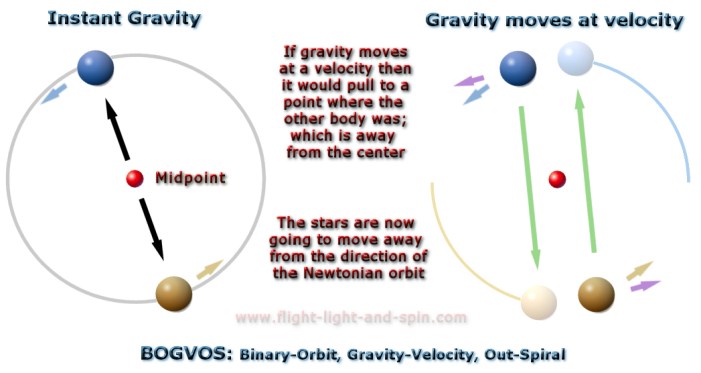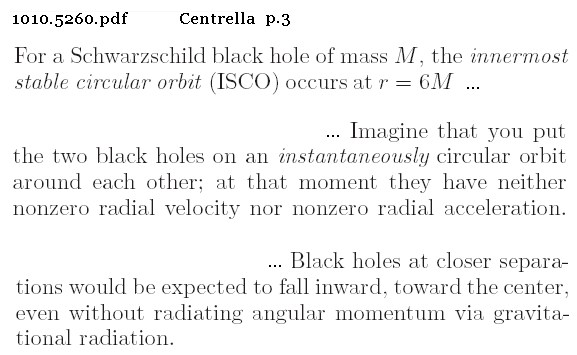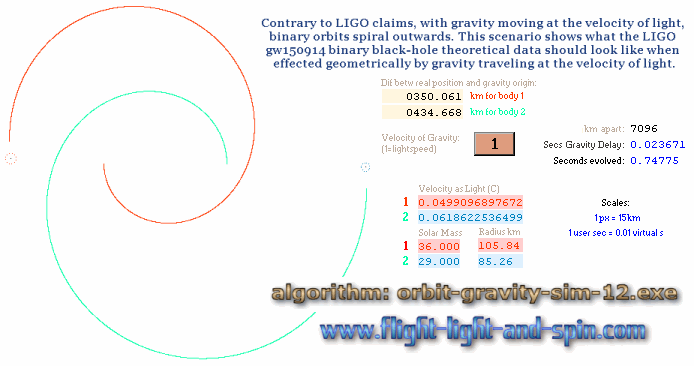| Numerical Relativity Numerical Relativity is a widely published computational paradigm with similar goals to this algorithm: orbit-gravity-sim-12.exe (OGS12). That purpose being to observe and predict the potential effects of Relativity on orbits, most especially binary orbits. The
article titled: ‘Black-hole
binaries, gravitational waves, and numerical relativity’ The paradigm of Numerical Relativity is intrinsically illogical for the simple reason that the geometric role of gravity moving at the velocity of light has been over-looked when applied to the geometry of all binary orbits – not just super-massive bodies like black-holes. Simply
put, my claim is that if a binary pair has gravity moving at the
velocity of light, then they will both not
be attracted to an opposite point perpendicular to their movements,
but instead they will attract to a previous point on the orbit-path.
This can only cause an outwards-spiral to the orbital binary because
attraction is to an angle behind the mid-point of the system, and
not through the mid-point. |
||
|
Even though it is quite apparent that Centrella (et al) have not even
vaguely considered the geometric effect on a binary system with gravity
moving at velocity, let us look at the premise that they begin with: . |
||
|
So we clearly have two given reasons for the alleged inward movement
of the binary black-holes towards the centre: Firstly, the Numerical
Relativist concept of ‘gravitational radiation’ –
which is said to result in a loss in mass and velocity – and
secondly the ‘fall inward, toward the center’ which
is the inwards spiral from General Relativity which Hawking measures
in electrical heaters: . |
||
|
At no point does any author even consider that a delay in gravity
must have a geometrical effect on the shape of a binary orbit. Scenario
[13] of the orbit-gravity-sim-11.exe
algorithm (OGS12) shows that a radical outwards spiral must result
from gravity travelling at the velocity of light for a binary system.
This scenario is at the scale that the Numerical Relativists suggest.
The outwards-spiral is a purely logical consequence, and is a far
larger effect than any other aspect of theoretical physics mentioned
in the Centrella article or any other historical reference: . |
||
|
Notice the orbit-path trailing behind the body in this image. This
represents the difference between the position of the body itself
and the position of the gravity-origin for the opposing body. This
difference is caused by the delay in gravity due to it supposedly
travelling at the velocity of light. I cannot say it any more clearly than this: There is zero evidence that any other Post-Newtonian theorist ever considered the role that the velocity of gravity plays in the geometry of an orbit: it causes a prodigious outwards spiral enormously greater than any other effect of any other Post-Newtonian theory on most orbits by a factor of roughly about a million times. . |
||
| This is an extract summary of Chapter XXX of the book: Flight Light and Spin Download page for relativity simulation: algorithm orbit-gravity-sim-12.exe The full chapter can be downloaded here: Sum-Theory.pdf (5.5 mb, 57 pages, this pdf file is too big for chrome, use firefox) List of: abbreviated short articles . . |
|||||







